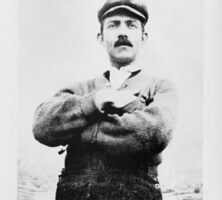Wallingford Riegger was a major figure in the world of American classical music for more than three decades. An avant-garde modernist whose major compositions severely tested the ability of audiences to comprehend new sounds and forms, Riegger refused to bow to either musical traditionalism or popular taste, making sacrifices in order to remain true to his artistic ideals. By the end of his life, many in the musical world acknowledged him as the dean of American composers.

From Wallingford Riegger: Two Essays in Musical Biography, by S. Spackman
Wallingford Constantine Riegger was born in Albany on April 29, 1885, to Ida Wallingford and Constantine Riegger. Both parents were musically gifted (his father was an accomplished violinist and his mother a talented pianist). In 1888 the family left Georgia after Constantine Riegger’s lumber mill burned to the ground. After living in Indianapolis and Louisville, Kentucky, the Riegger family moved to New York City in 1900. In 1907 Riegger, a gifted cellist, was a member of the first graduating class of New York’s Institute of Musical Arts, the precursor of the Juilliard School of Music. Over the next three years, Riegger took advanced courses in cello and composition at Berlin’s renowned Hochschule für Musik in Germany. He returned to New York in 1910, and in 1911 he married Rose Schramm, with whom he had three daughters.
Riegger returned to Germany in 1914 to advance his career. He worked as a vocal coach and conductor in several German cities, including Berlin. When World War I broke out between the United States and Germany in 1917, the Rieggers returned home. Over the next decade Wallingford accepted teaching positions in Iowa, upstate New York, and finally, New York City. In his limited leisure time Riegger composed. These works won recognition and major awards, including the Paderewski Prize (1922) and the Elizabeth Sprague Coolidge Prize (1924)—the first time this coveted honor was given to an American composer.

From Wallingford Riegger: Two Essays in Musical Biography, by S. Spackman
In 1928 Riegger left the academic world for the insecurity of living as an independent musical artist. For the remainder of his life, he earned his living as an editor and by arranging other musicians’ works.
By the late 1920s Riegger had become a musical modernist, inspired by Arnold Schoenberg’s atonal school. In his major orchestral works, including Study in Sonority (1927), Dichotomy (1932), String Quartet no. 2 (1948), Symphony no. 3 (1948), and Music for Brass Choir (1949), Riegger composed in a highly advanced, dissonant style that appealed much more to his fellow musicians than to the average concertgoer. Composer Henry Cowell admiringly described one of Riegger’s works as “the choiring of angels.” A critic, however, heard sounds resembling “a dying cow emitting mournful groans.”
In the 1930s Riegger composed music for America’s most innovative dancers, including Martha Graham, Hanya Holm, and Doris Humphrey. His best dance scores, composed for Humphrey, are New Dance and With My Red Fires, and with these works modern dance emerged as a true symphonic ballet. New Dance is generally regarded as the first modern dance work of extended length.
In March 1955 Riegger traveled to his hometown of Albany for the world premiere performance of Dance Rhythms, a genial orchestral work that brought him a standing ovation from a capacity audience. Far less pleasant was his appearance in April 1957 before the notorious House Committee on Un-American Activities in Washington, D.C., which was investigating subversion and communism in the musical world. Riegger refused to answer the committee’s questions, standing on the rights guaranteed him in the First Amendment of the U.S. Constitution. The New York Post columnist Murray Kempton praised Riegger for his display of personal integrity in the face of governmental pressure.
In October 1958 conductor Leonard Bernstein and the New York Philharmonic honored Riegger by performing his Music for Orchestra. Bernstein praised Riegger as a pioneer of musical modernism in America, a creative artist who was “salty, peppery, crusty, unconventional and eternally young in spirit.” In late March 1961 Riegger fell, having tripped on the leash of a dog fighting with another dog in New York. Despite emergency surgery the trauma proved to be fatal, and Riegger died on April 2, 1961.






